1. Introduction & Overview
What is Remote Robot Monitoring?
Remote Robot Monitoring (RRM) refers to the real-time observation, diagnostics, and management of robotic systems (physical or virtual) over a network. These robots may range from industrial robots, RPA (Robotic Process Automation) bots, autonomous systems, or even cloud-deployed AI bots.

History or Background
- Industrial robotics began integrating with networked systems in the 2000s.
- With the rise of RPA and autonomous systems, DevOps tools extended their capabilities to robotic fleet management.
- Recent evolution focuses on real-time telemetry, predictive diagnostics, and anomaly detection, aligned with DevSecOps principles for secure deployment and operations.
Why is it Relevant in DevSecOps?
- Security: Robots often run in critical systems (factories, health, defense). RRM enforces security policies and detects anomalies.
- Compliance: Ensures robot operations follow SOPs, ISO standards.
- Automation: Enables CI/CD of robot firmware, configurations, and AI models.
- Incident response: Enables automated rollback, alerts, or shutdowns.
2. Core Concepts & Terminology
Key Terms and Definitions
| Term | Definition |
|---|---|
| Robot Telemetry | Real-time data from sensors, actuators, logs, etc. |
| Digital Twin | A virtual replica of the robot used for simulations. |
| Edge Device | A gateway device connected to robots for processing. |
| Heartbeat Monitoring | Health-check ping to verify the robot’s availability. |
| OTA (Over-the-Air) Updates | Remotely delivering firmware or configuration changes. |
How It Fits into the DevSecOps Lifecycle
| DevSecOps Phase | RRM Involvement |
|---|---|
| Plan | Define monitoring and compliance rules. |
| Develop | Integrate robot SDKs, logging frameworks. |
| Build | Containerize robot simulators or firmware logic. |
| Test | Simulate failures and test observability. |
| Release | Deploy robot logic with monitoring hooks. |
| Operate | Monitor robot performance and alerts in real time. |
| Secure | Detect anomalies, enforce zero-trust, secure comms. |
3. Architecture & How It Works

Components & Workflow
[Robot (Edge/Firmware)]
|
[Local Gateway / Edge Agent]
|
[Telemetry Collector + Alert Engine]
|
[Monitoring Backend (Cloud)]
|
[DevSecOps Dashboards / CI-CD / SIEM Tools]
Internal Workflow
- Robot Data Collection: Sensors and logs pushed to edge agents.
- Secure Transmission: Encrypted transfer to central monitoring servers.
- Processing: Real-time analytics, ML-based anomaly detection.
- Dashboards & Alerts: Custom dashboards and rule-based alerts.
- CI/CD Hooks: Trigger robot software updates via pipelines.
Integration Points with CI/CD and Cloud Tools
| Tool | Integration |
|---|---|
| GitHub Actions | Deploy updated monitoring scripts to edge devices. |
| Jenkins | Trigger test robot behaviors in simulated environments. |
| AWS IoT Greengrass | Manage remote device lifecycle and telemetry. |
| Azure Monitor | Integrate robotic systems into full Azure observability. |
4. Installation & Getting Started
Prerequisites
- Cloud account (AWS/GCP/Azure)
- Robot simulator or physical device (e.g., TurtleBot, UR5)
- IoT/Edge agent installed (e.g., AWS Greengrass, ROSbridge)
- Monitoring platform (e.g., Grafana + Prometheus, Datadog, ELK)
Beginner-Friendly Setup Guide
# Step 1: Set up edge monitoring agent on robot
sudo apt install rosbridge-server
roslaunch rosbridge_server rosbridge_websocket.launch
# Step 2: Configure telemetry to push to a central server
export MONITOR_URL=https://monitoring.example.com
python3 telemetry_pusher.py --url $MONITOR_URL
# Step 3: Setup Prometheus to scrape telemetry
# prometheus.yml
scrape_configs:
- job_name: 'robot_telemetry'
static_configs:
- targets: ['edge-agent-ip:9090']
# Step 4: Visualize in Grafana
# Import Prometheus dashboard template
5. Real-World Use Cases
1. Manufacturing Plant Monitoring
- 100+ robotic arms monitored via edge gateways.
- Downtime prediction using historical vibration logs.
2. Warehouse Robotics (Amazon Kiva-style)
- Real-time load distribution & alert on traffic congestion.
- OTA path optimization via DevOps pipeline.
3. Healthcare Robots
- Patient-assisting robots monitored for battery, position, emergency triggers.
- Integrated with HIPAA-compliant alerting.
4. Autonomous Drone Fleets
- Live telemetry feed monitored for altitude, signal strength.
- CI/CD updates to navigation algorithm via GitOps.
6. Benefits & Limitations
✅ Key Advantages
- Real-time visibility into remote operations.
- Fast incident response through automated alerts.
- Regulatory compliance and audit trails.
- Centralized control of distributed systems.
❌ Limitations
- High bandwidth consumption with video-based telemetry.
- Latency in remote areas can delay reactions.
- Security risks if not encrypted properly (e.g., robot hijack).
- Complex setup if working with diverse robot ecosystems.
7. Best Practices & Recommendations
🔐 Security
- Enforce TLS/SSL for all robot-cloud communications.
- Use mutual authentication for edge agents.
- Regular firmware scanning with DevSecOps tools (e.g., Anchore).
⚙️ Performance
- Offload heavy processing to edge gateways.
- Use event-based triggers instead of frequent polling.
🧾 Compliance & Automation
- Log every robot action with timestamp and metadata.
- Use Terraform or Ansible for infrastructure as code (IaC).
- Automate alerting workflows with Slack, PagerDuty, or SIEM.
8. Comparison with Alternatives
| Feature | Remote Robot Monitoring | RPA Monitoring | Industrial SCADA | APM (App Perf Monitoring) |
|---|---|---|---|---|
| Real-Time Hardware Telemetry | ✅ | ❌ | ✅ | ❌ |
| Cloud-Integrated | ✅ | ✅ | ⚠️ (legacy) | ✅ |
| Security Focus (DevSecOps) | ✅ | ⚠️ | ⚠️ | ✅ |
| OTA Support | ✅ | ⚠️ | ❌ | ❌ |
| Cost | Medium | Low | High | Medium |
When to Choose RRM?
- You’re dealing with physical or embedded robotics.
- You need real-time anomaly detection and secure telemetry.
- You’re integrating with CI/CD pipelines or cloud-native systems.
9. Conclusion
Final Thoughts
Remote Robot Monitoring is an essential part of the modern DevSecOps toolkit when working with intelligent, autonomous, or industrial robotic systems. With the proper architecture, tooling, and security protocols, organizations can scale robotic operations while maintaining resilience, performance, and compliance.
Future Trends
- AI-based self-healing robots.
- Integration with Digital Twin platforms.
- Zero-trust robotics networking (ZTRA).